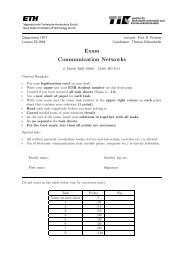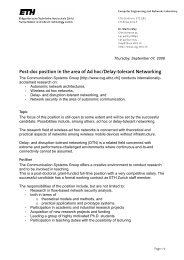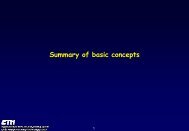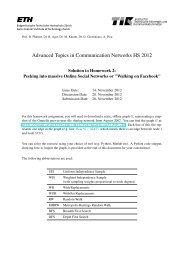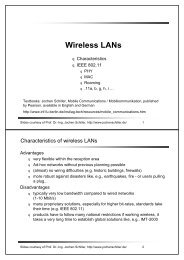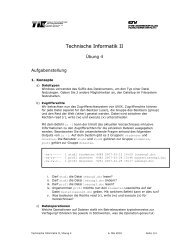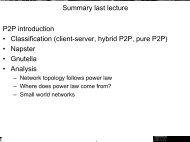Direct link multi-access networks Problem statement
Direct link multi-access networks Problem statement
Direct link multi-access networks Problem statement
You also want an ePaper? Increase the reach of your titles
YUMPU automatically turns print PDFs into web optimized ePapers that Google loves.
Issues to be considered• Performance: f(number of stations, traffic load, trafficcharacteristics, parameters of medium)– Total throughput– Throughput of each station– Medium <strong>access</strong> delay• Fairness: Does every station receive a similar service?5Aloha medium <strong>access</strong> algorithm/* send one frame */repeatsend(data)r=receive()if r ack thenwait_random_timeenduntil r=ack6
Model for the Aloha medium <strong>access</strong> algorithmS = Gp erferfolgreichsuccessgesendetSenden einesSend kollidierten framePaketswith p=q(mitWahrsch. q rr)idle freiNeuzugang New frame (mitWahrsch. with p=qq aa)A = λmG = λ 1msending sendenbackloggedKollision collision7Scenario for calculating the throughputFrames colliding with observed framemmmt 0 -m t 0 t 0 +mvulnerable intervalt 0 +2m8
Carrier Sense Multiple Access (CSMA)/* send one frame */Repeatwait_channel_available()send(data)r=receive()if r ack thenwait_random_timeenduntil r=ack9Model for CSMAerfolgreichsuccessgesendetidlefreiNeuzugang New frame(mitWahrsch. with p=q q aa)Senden einesSend kollidierten framePakets with p=q (mit rWahrsch. q r)Kan.checkprüfenKan.Channel availablefreisendingsendenbackloggedKanal chan.occupiedbesetztcollisionKollision10
Vulnerable interval with CSMAP1(A)ABP1(B)xτ = t p+ t Dτ = t p+ t Dvulnerable verletzliches interval Intervall2 τt11Performance tuning of CSMAMaximum throughput isroughly indirectlyproportional to β:β = τ /m = (τ ∗ C) / Lτ: Propagation delay [s]m: Frame length [s]L: Frame length [bit]C: Transmission rate [bit/s]For good performance, βshould be
CSMA/CD AlgorithmBinaryExponentialBackoff/* send one frame */t=1Repeatwait_channel_available()r=monitor_while_sending(data)if r = collision thenwait_random_time(t)t=2*tenduntil r=success15Achievable throughput for various variants16
Throughput with different b10.8Vergleich CSMA mit CSMA/CD, beta=0.01 resp. 0.1CSMA/CDS0.60.40.2CSMACSMA/CDCSMA00 50 100 150 200 250 300G17Medium <strong>access</strong> delay increases with load18
Ethernet history• Developed at Xerox Palo Alto Research Center (PARC)• Patent see http://www.delphion.com/details?pn=US04063220__(1st page)• CSMA/CD medium <strong>access</strong> control algorithm• Industry standard set by DEC, Intel, Xerox (DIX), 1978• Standardized by IEEE (802.3) and ISO (8802-3)• Variants:– (3 Mbit/s) 10 Mbit/s, 100 Mbit/s, 1 Gbit/s– Thick coax, thin coax, STP, UTP, fiber– Segment lengths: 500 m, 200 m, 100 m– Baseband and modulated carrier versions• Ethernet is a success story19IEEE 802.x standard architecturenetworklogical <strong>link</strong> control (LLC)medium <strong>access</strong> control (MAC)<strong>link</strong>physicalmediummedium20
• MAC sub-layerIEEE 802.3 service interfaces– Connectionless, unreliable– unicast, <strong>multi</strong>cast, and broadcast addressing– FCS checked• LLC sub-layer– Type 1: connection-less, unreliable, all addressing modes– Type 2: connection-oriented, reliable, flow control, …– Type 3: connection-less, request / response type of service21CSMA/CD Frame Format7 1 2/6 2/6 2 max. 1500 max. 46 4 (byte)preambleSFDDASA length payload pad fcspreamble:SFD:DA:SA:length:payload:pad:FCS:Bit synchronizationByte synchronizationDestination addressSource addressLength of payloadUpper layer frameTo fill up a short frame32-Bit CRC for error detection22
CSMA/CD frame format7 1 2/6 2/6 2 max. 1500 max. 46 4preambleSFDDASA length payload pad fcsInterim DIX Ethernet frame format7 1 2/6 2/6 2 max. 1500, min. 46 4preambleSFDDASAtypepayloadfcs23Technical realizations24
Current technology• Shared medium: Realized as a hub with UTP unshieldedtwisted pair cabling• Not more than 4 hubs in between any station in the network• Network diameter max. 500 m• 10 Mbit/s, 100 Mbit/s, (1000 Mbit/s)• Hubs are being replaced by switches in professionalenvironments25Hubs vs. LAN Switches– At similar locations in <strong>networks</strong>.– Hubs repeat all packets while switches examine all of them.– Switches require address examination and forwarding.• Store-and-forward: Analyze the entire packet.• Cut-through: Examines destination and starts forwarding.• Blocking vs. non-blocking (highly parallel) architectures.• Buffering: backpressure or large buffers.• Half-duplex and full-duplex modes (if 4-wire cables used)• CSMA/CD collision domain is greatly reduced or even eliminatedB C D EB C D EAHubFASwitchFto E26to E
Topologies (1)• Shared backboneand sharedworkgroup LANs• SwitchedBackbone(collapsedbackbone)• MultiswitchBackbone27Topologies (2)• WorkgroupSegmentation(decentralized)• WorkgroupSegmentation(centralized)• MicroSegmentation28
Fast Ethernet• 100 Mbit/s version of Ethernet, using CSMA/CD algorithm(later addition to IEEE 802.3).– 10 times faster than “normal” Ethernet, and 10 times smaller(max. app. 200 m between stations).– Easy upgrade path from Ethernet, simply replace Ethernethubs, adapters, and driver software!– Autosensing of physical media (10/100 Mbit/s)• Works with several physical media:Physical Layer Media Types100BASE-TX 2 pairs category 5 balanced cable, or 2 pairs 150 ohmshielded balanced cable as defined by ISO/IEC11801100BASE-FX 2 <strong>multi</strong>-mode fiber as defined by ISO 9314100BASE-T44 pairs of category 3, 4 or 5 balanced cable asdefined by ISO/IEC 1180129Gigabit Ethernet• Marketing aspect:– Term Ethernet used to hint at easy and cheap upgrade,reliability.• Theory is different:– CSMA/CD = Ethernet (historically)– If CSMA/CD is used on a shared medium, the allowable sizeof a Gigabit Ethernet segment will be rather small (roughly20 m). Shared Gbit-Ethernet is not very useful.– If CSMA/CD is not used, is it still an Ethernet?• Realistically, a Gigabit/s LAN need not be a CSMA/CDbasedLAN to grant compatibility.– Important are cost, compatibility with existing cabling, andavailability of good drivers for popular operating systems.30
Gigabit Ethernet – Objectives• IEEE 802.3z working group key objectives:– Half- and full-duplex operation at 1000 Mbit/s.– Complying with IEEE 802.3 Ethernet frame format.– Applying CSMA/CD <strong>access</strong> method. (!)– Allowing one repeater per physical collision domain.– Providing address compatibility with Ethernet and FastEthernet technologies.31Gigabit Ethernet – Layering• New enhanced interface: GMII– Support of different physical media: 10…1000 Mbit/s.– Automated detection of media type.– State and statistics of current connections.Logical Link Control (LLC)Data Link LayerMedia Access Control (MAC)Gigabit Media Independent Interface(GMII)Physical LayerPhysical (PHY)Medium32
Gigabit Ethernet Layering and Standards33Gigabit Ethernet – Frames• Frames compatible withclassic Ethernet.Preamble7 Byte• Preamble: 101010 … 10.• Start Delimiter: 10101011.• Padding: Even # of Bytes.• Extension used to safelydetect collisions.• Bursts: Concatenation ofmax. 65536 Byte.TransmissionStart Frame DelimiterDestination AddressSource AddressLength/TypeDataPaddingFrame Check SequenceExtension1 Byte6 Byte6 Byte6 Byte1518 Byte0/1 Byte4 Bytebit 0 bit 7MAC Frame/Extension Inter Frame MAC Frame Inter Frame MAC FrameBurst Limit34
Gigabit Ethernet – Physical Layer• Symbols are used to code MAC data:– 8B/10B coding scheme (8 bit user data/10 bit phy. data)– Code-inherent clock regeneration.– Always min 4 and max 7 state changes per symbol.– 1250 Mbaud.– Code group symbols (always different to data symbols):• Carrier Extension,• Idle,• Start-of-Packet,• End-of-Packet,• Configuration Marks, and• Violations.35Gigabit Ethernet – Physical Media• Standard for UTP cabling accepted in June 1999 (802.3ab,1000BASE-T)• Smaller distances for fiber cabling compared to Fast Ethernet andFDDI due to dispersion.Type Cabling Waves Distance Plugs1000BASE-SX62,5 µm FiberMultimode830 nm2 – 260 mDuplex SC1000BASE-SX50,0 µm FiberMultimode830 nm2 – 550 mDuplex SC1000BASE-LX62,5 µm FiberMultimode1270 nm2 – 550 mDuplex SC1000BASE-LX50,0 µm FiberMultimode1270 nm2 – 550 mDuplex SC1000BASE-LX10,0 µm FiberMonomode1270 nm2 – 3000 mDuplex SC1000BASE-CXSTPTwinax25 mDB9 (Style 1)1000BASE-CXIEC 61076Twinax25 mIEC (Style 2)1000BASE-TUTP, Cat 5100mRJ-4536
Other wire-based LAN standards ...... are only of historical interest• IEEE 802.5 Token Ring• IEEE 802.4 Token Passing Bus• IEEE 802.6 Distributed Queue Dual Bus MAN• IEEE 802.12 Demand Priority Access (voice-grade anylan)37Complete list of IEEE 802 LAN Standards802.1: LAN/MAN Bridging &Management (.1p, .1q)802.2 Logical Link Control*802.3 CSMA/CD Access Method(.3z)802.4 Token-Passing Bus* AccessMethod802.5 Token Ring Access Method802.6 DQDB Access Method*802.7 Broadband*802.8 Fiber Optic802.9 Integrated Services /Isochronous LAN802.10: LAN/MAN Security802.11: Wireless LAN802.12: Demand Priority AccessMethod802.13 n/a (!)802.14: Cable Modems*: inactive38



